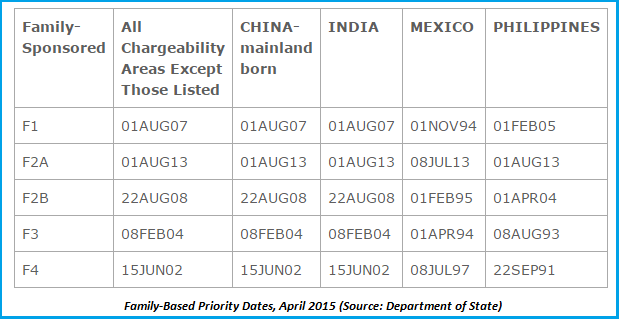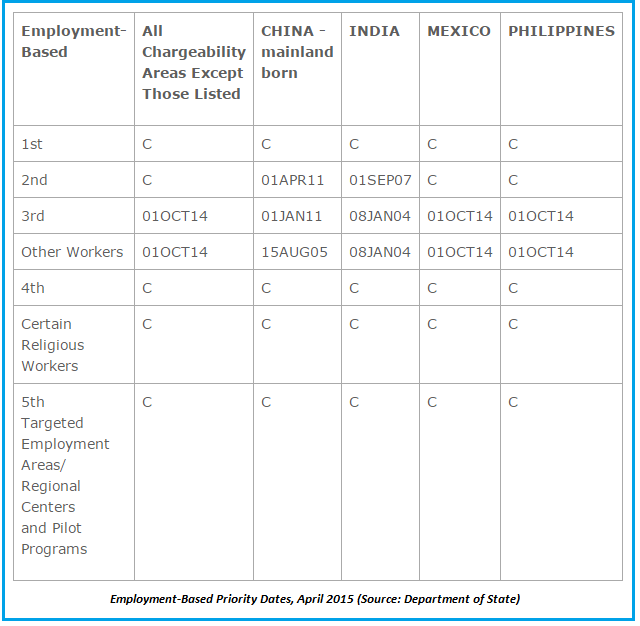April Visa Bulletin: China EB-2 finally moves ahead of China EB-3; big advance for India EB-2 and many other employment-based categories; moderate progress for most family-based categories
March 19, 2015
There is quite a bit of movement in April’s visa bulletin, particularly in employment-based categories. For the first time in a long time, China’s EB-2 preference category is closer to current than its EB-3 category, thanks to a 7 month advancement for the former, and a 9+ month retrogression for the latter. Most other employment-based categories will also see forward movement of 4 months or more, excepting India EB-3 (1 week forward) and the previously-mentioned retrogression for China EB-3.
Most family-based categories will make incremental advancements, except for F-1 categories, most of which are static.
Full breakdowns, plus the DOL charts, are below.
Family-Based Preference Categories
Retrogressing: None
No Movement: F-1 China; F-1 India; F-1 Philippines; F-1 All Other
Advancing less than 1 week: None
Advancing 1-2 Weeks: F-1 Mexico; F-2B Philippines; F-3 China; F-3 India; F-3 Philippines; F-4 Philippines
Advancing 2 weeks – 1 month: None
Advancing 1-2 months: F-2A China; F-2A India; F-2A Mexico; F-2A Philippines; F-2A All Other; F-2B China; F-2B India; F-2B Mexico; F-3 Mexico; F-4 China; F-4 India; F-4 Mexico
Advancing 2-6 months: None
Advancing 6+ months: None
Employment-Based Preference Categories
Remaining Current: EB-1 (all areas); EB-2 Mexico; EB-2 Philippines; EB-4, Certain Religious Workers, and 5th Targeted (all areas)
Retrogressing: EB-3 China (retrogressing 9+ months)
No Movement: Other Workers China
Advancing less than 1 week: None
Advancing 1-2 Weeks: EB-3 India; Other Workers India
Advancing 2 weeks – 1 month: None
Advancing 1-2 months: None
Advancing 2-6 months: EB-3 Mexico; EB-3 Philippines; EB-3 All Other; Other Workers Mexico; Other Workers Philippines; Other Workers All Other
Advancing 6+ months: EB-2 China (advances 7 months); EB-2 India (advances 8 months)
Newly Current: None
Forward Guidance from the DOS:
The Department of State published the following guidance regarding the retrogression for China EB-3, plus a warning of coming retrogression for EB-5 later this year:
Employment Third Preference: The cut-off date for this category was advanced very rapidly during the past seven months, in an attempt to generate demand to ensure that all numbers under the annual limit could be made available. Item E in the November 2014 Visa Bulletin notified readers that this rapid movement could require “corrective” action as early as February, once demand began to materialize.
Continued heavy demand by applicants with very early priority dates has required a retrogression of this cut-off date for the month of April, to hold number use within the annual numerical limit. Potential forward movement of this cut-off date during the remainder of the fiscal year is dependent on the amount of demand received for applicants with very early priority dates.
Employment Fifth Preference: Item D of the February Visa Bulletin advised readers that the expected increase in demand would require the establishment of a cut-off date during the summer to hold number use within the annual numerical limit. The establishment of that date can be expected no later than June.
July 16, 2025
Department of State Releases August 2025 Visa Bulletin The DOS released its August 2025 Visa Bulletin. For August 2025, USCIS determines that for all family-sponsored preference categories, you...MoreJuly 10, 2025
TPS Terminated for Nicaragua On July 8, 2025, DHS Secretary Noem announced the decision to terminate Temporary Protected Status for Nicaragua. This termination is...More





